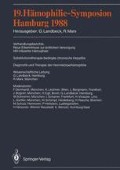Zusammenfassung
Der mögliche Stammbaum der Retroviren ist in Abb. 1 dargestellt. Auf der linken Seite sind die Viren aufgezeigt, die nach Eintritt in die Zelle zu einer ungeregelten Proliferation führen und damit zum Entstehen von Neoplasien, z.B. Leukämie. Im Menschen sind seit längerem HTLV-1 und 2 bekannt, neu dazu gekommen ist das HTLV-5 (humanes T-Leukämie-Virus, Typ 5), welches als Erreger der Mycosis fungoides (SEZARY-Syndrom) gilt [1]. Alle 3 onkogenen Viren haben für die Hämophilie eine untergeordnete Bedeutung, da die Prävalenz in Deutschland sehr gering ist und da diese Viren über die heute üblichen Inaktivierungsverfahren, wie auch HIV, zerstört werden. Sie sind von geringer Pathogenität.
Access this chapter
Tax calculation will be finalised at checkout
Purchases are for personal use only
Preview
Unable to display preview. Download preview PDF.
Literatur
Manzari V, Gismondi A, Barrialari G et al. (1987) HTLV-V: A new human retrovirus isolated in a Tac-negative T cell lymphoma/leukemia. Science 238:1581–1583
Sharp PM, Li WH (1988) Understanding the origins of AIDS viruses. Nature 336:315
Myers G (1988) Los Alamos, HIV sequence database. Los Alamos National Laboratory, Los Alamos, New Mexico, USA
Haseltine WA (1988) Replication and pathogenesis of the AIDS virus. JAIDS 1:217–240
Skolmik PR, Lostoff BR, Hirsch MS (1988) Bidirectional interactions between human immunodeficiency virus type 1 und cytomegalovirus. J Inf Dis 157:508–514
Ho DD, Pomerantz RJ, Kaplan JC (1987) Pathogenesis of infection with human immunodeficiency virus. N Engl J Med 317:278–286
Gyorkey F, Melnick JL, Gyorkey P (1987) Human immunodeficiency virus in brain biopsies of patients with AIDS and progressive encephalopathy. J Inf Dis 155:870–876
Nelson JA, Wiley CA, Köhler CR et al. (1988) Human immunodeficiency virus detected in bowel epithelium from patients with gastrointestinal symptoms. Lancet I:259–262
Lange JMA, de Wolf F, Krone WJA et al. (1987) Decline of antibody reactivity to outer viral core protein p17 is an earlier serological marker of disease progression in human immunodeficiency virus infection than anti p24 decline. AIDS 1:155–159
Pan LZ, Mayer CC, Levy JA (1987) Patterns of antibody response in individuals infected with human immunodeficiency virus. J Inf Dis 155:626–632
Goudsmit J, Paul DA (1987) Circulation of HIV antigen in blood according to stage of infection, risk group, age, and geographic origin. Epidemiol Inf 99:701–710
Paul DA, Falk LA, Kessler HA et al. (1987) Correlation of serum HIV antigen and antibody with clinical status in HIV infected patients. J Med Virol 22:357–363
Kenny C, Parkin J, Underhill G et al. (1987) HIV antigen testing. Lancet I:565–566
Lange MAJ, Paul DA, Huismann HG et al. (1986) Persistent HIV antigenaemia and decline of HIV core antibodies associated with transition to AIDS. Br Med J 293:1459–1462
Chaisson RE, Allein JP, Leuther M, Volberding PA (1986) Significant changes in HIV antigen level in the serum of patients treated with azidothymidine. N Engl J Med 315:1610–1611
Reiss P, Lange JMA, Boucher CH et al. (1988) Resumption of HIV antigen production during continuous zidovudine treatment. Lancet I:421
Shaw GM, Harper ME, Hahn BH et al. (1985) HTLV-III infection in brains of children and adults with AIDS encephalopathy. Science 227:177–182
Koenig S, Gendelmann HE, Orenstein JM et al. (1986) Detection of AIDS virus in macrophages in brain tissue from AIDS patients with encephalopathy. Science 233:1089–1093
Loche M, Mach B (1988) Identification of HIV infected seronegative individuals by a direct diagnostic test based on hybridisation to amplified viral DNA. Lancet II:418–421
Laure R, Rouzioux C, Veber F et al. (1988) Detection of HIV-1 DNA in infants and children by means of the polymerase chain reaction. Lancet II:538–541
Hert C, Spira T, Moore J et al. (1988) Direct detection of HIV RNA expression in seropositive subjects. Lancet II:596–599
Klasse PJ, Pipkorn R, Blomberg J (1988) Presence of antibodies to a putatively immunosuppresive part of human immunodeficiency virus (HIV) envelope glycoproteins gp41 is strongly associated with health among HIV-positive subjects. Proc Natl Acad Sci 85:5225–5229
Sarin PS, Sun DK, Thornton AH et al. (1986) Neutralization of HTLVIII/LAV replication by antiserum to thymosin α1. Science 232:1135–1137
Brennemann DE, Westbrook G, Fitzgerald SP et al. (1988) Neuronal cell killing by the envelope protein of HIV and its prevention by vasoactive intestinal peptide. Nature 335:639–642
Author information
Authors and Affiliations
Editor information
Editors and Affiliations
Rights and permissions
Copyright information
© 1989 Springer-Verlag Berlin Heidelberg
About this paper
Cite this paper
Gürtler, L., Eberle, J., Deinhardt, F. (1989). Virologie der HIV-Infektion — Primär- und Verlaufsdiagnostik. In: Landbeck, G., Marx, R. (eds) 19. Hämophilie-Symposion Hamburg 1988. Springer, Berlin, Heidelberg. https://doi.org/10.1007/978-3-642-75053-3_4
Download citation
DOI: https://doi.org/10.1007/978-3-642-75053-3_4
Publisher Name: Springer, Berlin, Heidelberg
Print ISBN: 978-3-540-51667-5
Online ISBN: 978-3-642-75053-3
eBook Packages: Springer Book Archive

